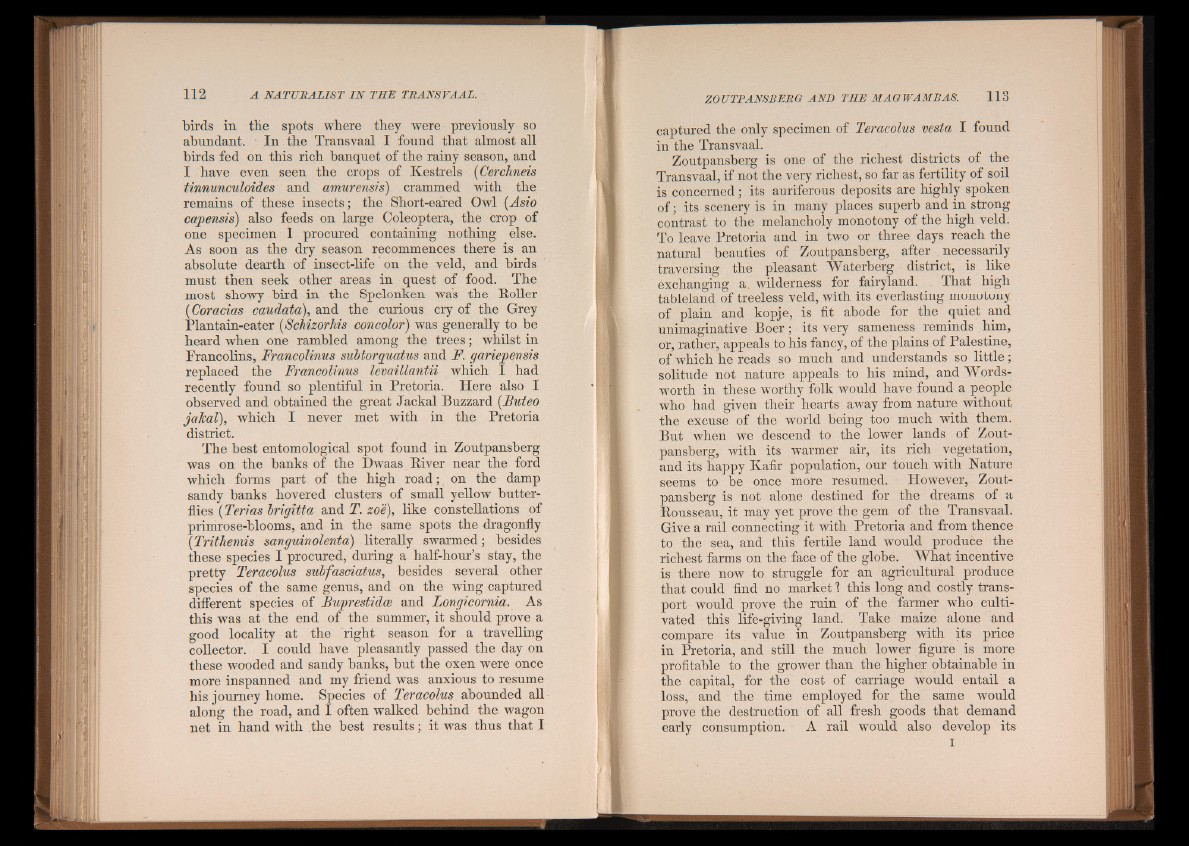
birds in. tbe spots where they were previously so
abundant. In the Transvaal I found that almost all
birds fed on this rich banquet of the rainy season, and
I have even seen the crops of Kestrels (Cerchneis
tinnunculoid.es and amurensis) crammed with the
remains of these insects; the Short-eared Owl (Asio
capensis) also feeds on large Coleoptera, the crop of
one specimen I procured containing nothing else.
As soon as the dry season recommences there is an
absolute dearth of insect-life on the veld, and birds
must then seek other areas in quest of food. The
most showy bird in the Spelonken was the Roller
(Coracias caudata), and the curious cry of the Grey
Plantain-eater (Schizorhis concolor) was generally to be
heard when one rambled among the trees; whilst in
Francolins, Francolinus subtorquatus and F. gariepensis
replaced the Francolinus levaillantii which I had
recently found so plentiful in Pretoria. Here also I
observed and obtained the great Jackal Buzzard (Buteo
jaTcal), which I never met with in the Pretoria
district.
The best entomological spot found in Zoutpansberg
was on the banks of the Dwaas River near the ford
which forms part of the high road; on the damp
sandy banks hovered clusters of small yellow butterflies
(Terias brigitta and T. zoe), like constellations of
primrose-blooms, and in the same spots the dragonfly
(Trithemis sanguinolenta) literally swarmed; besides
these species I procured, during a half-hour’s stay, the
pretty Teracolus subfasciatus, besides several other
species of the same genus, and on the wing captured
different species of Buprestidce and Longicornia. As
this was at the end of the summer, it should prove a
good locality at the right season for a travelling
collector. I could have pleasantly passed the day on
these wooded and sandy banks, but the oxen were once
more inspanned and my friend was anxious to resume
his journey home. Species of Teracolus abounded all
along the road, and I often walked behind the wagon
net in hand with the best results; it was thus that I
captured the only specimen of Teracolus vesta I found
in the Transvaal.
Zoutpansberg is one of the richest districts of the
Transvaal, if not the very richest, so far as fertility of soil
is concerned ; its auriferous deposits are highly spoken
of; its scenery is in many places superb and in strong
contrast to the melancholy monotony of the high veld.
To leave Pretoria and in two or three days reach the
natural beauties of Zoutpansberg, after necessarily
traversing the pleasant Waterberg district, is like
exchanging a. wilderness for fairyland. That high
tableland of treeless veld, with its everlasting monotony
of plain and kopje, is fit abode for the quiet and
unimaginative Boer; its very sameness reminds him,
or, rather, appeals to his fancy, of the plains of Palestine,
of which he reads so much and understands so little;
solitude not nature appeals to his mind, and Wordsworth
in these worthy folk would have found a people
who had given their hearts away from nature without
the excuse of the world being too much with them.
But when we descend to the lower lands of Zoutpansberg,
with its warmer air, its rich vegetation,
and its happy Kafir population, our touch with Nature
seems to be once more resumed. However, Zoutpansberg
is not alone destined for the dreams of a
Rousseau, it may yet prove the gem of the Transvaal.
Give a rail connecting it with Pretoria and from thence
to the sea, and this fertile land would produce the
richest farms on the face of the globe. What incentive
is there now to struggle for an agricultural produce
that could find no market \ this long and costly transport
would prove the ruin of the farmer who cultivated
this life-giving land. Take maize alone and
compare its value in Zoutpansberg with its price
in Pretoria, and still the much lower figure is more
profitable to the grower than the higher obtainable in
the capital, for the cost of carriage would entail a
loss, and the time employed for the same would
prove the destruction of all fresh goods that demand
early consumption. A rail would also develop its
I